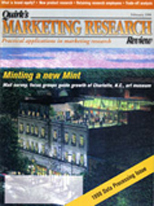Editor’s note: Robert Sullivan is president of RCS Management Group, an Akron, Ohio, reseller of mapping software and sales-automation software.
In a Niagara of numbers, some statistics may be overlooked in traditional rows and columns of data. When spatial relationships of data are viewed via maps, significant research findings may be found more quickly and easily.
Frequently used in sales and marketing, PC-generated maps can add value to research and enhance research reports. During the past five years, economical, easy-to-use PC software has replaced manual methods of mapping (e.g., pushpins in wall maps and color markers on travel maps).
This article describes a mapping application in which results from a survey are mapped by state. (With enough returns per county or ZIP code, survey data could also be mapped by these areas.) The survey, conducted among manufacturing engineers and managers, determined the number of manufacturing machines installed, and to be purchased, in the U.S. American Machinist magazine (Penton Publishing, Cleveland, Ohio) conducted the survey known as the "15th Inventory of Manufacturing Equipment."
More than numbers
Basic statistics in the manufacturing-equipment survey include: 1) number of machines by type of machine (computer controlled vs. non-computer controlled) and equipment age; 2) SIC, size (number of employees), and location of plants where machines are installed/to be purchased.
Traditional printouts with these data provide essential information and permit analyses and crosstabulation. However, geographic analyses of the same data yield at-a-glance comparisons of survey data (primary and secondary data), as well as enhance the presentation of data (one’s report really stands out from others with color maps).
Let’s say you’re presenting survey data to sales and marketing management who will be establishing new or revised sales territories for a manufacturer or distributor. Sales territories are geographic and, thus, can easily be analyzed with maps.
Knowing the number of installed machines (drilling machines, turning machines, etc.), per state, you can divide the country into manageable, fairly distributed territories. Your own customers and prospects could be mapped on an overlay to see how you compare with the total universe.
Both the location and features (characteristics) of database names can be mapped and identified in terms of name criteria, for instance, customer sales volume or buying power, and not just the number of machines (or whatever product you sell, or sell to).
Maps displaying features or themes are called thematic maps. Typical thematic codes are colors, shades of gray, fill patterns (crosshatches, dots, etc.), and symbols (circles, squares, etc.). A circle might represent a customer, while a square could designate a prospect. When symbols are colored, or their size varied, additional feature information can be expressed. A red square or a large circle, for instance, could mean a high sales volume prospect or territory.
The power of PC mapping is limited only by your creativity. Many mapping software products let you create bar charts, pie charts, line graphs, and tables - for a complete presentation.
Maps help when selecting names
So far, we’ve seen how a map can help present and analyze survey results. This is the completion end. Maps can also help with the start of a research project.
Let’s say you wanted to know how many names would be available in a given location for a focus group survey, or how many names could be expected within a given distance of a city. Mapping software, operating on a database of names, can come up with a name count in minutes, versus hours by hand. Selection criteria, such as SIC, company size, job title, or whatever information is in one’s database, can be part of the name selection.
This geographic search is not limited to a radius, known as a buffer. Searches can be made for the number of names in a buffer such as "x" miles on either side of a highway, within a given sales territory, within a telephone area code, or within "x" miles of a shopping mall, distribution center, or warehouse.
Not all data mapped has to be from your own database; there are many outside geographic data references such as census tracts, designated market areas, population, buying-power indexes, total business establishments, and total employment.
How to get started
You can do desktop mapping yourself or subcontract to a value-added software reseller (VAR) or consultant. PC mapping is part of a larger system called GIS (geographic information system). VARs and consultants might be under a "GIS" listing, or under "Mapping."
PC mapping with adequate capabilities starts at $1,300. Included are maps for the U.S. and world, states, counties, and ZIP codes. Counties and ZIP codes, in basic mapping packages, are centroid points (used for "geocoding" - affixing latitude and longitude coordinates to objects to be mapped).
A VAR or consultant can demonstrate software, show sample maps, discuss case histories, and help select hardware/software. To do PC mapping yourself, in a Windows environment, with minimum features, you’ll need:
- an IBM 486/33 computer or compatible, with 4MB memory and at least 120MB hard disk; mouse; Windows 3.1;
- a Windows-supported printer or plotter;
- mapping software to manipulate data and produce maps (software capabilities from simple presentations to integrated information systems, including maps, charts, tables, database management, and statistics);
- geographic data to identify locations, such as the U.S., states, counties, ZIP codes, and streets;
- your database;
- outside references such as government data and business statistics (optional, to complement one’s own database);
- a person to learn and operate the PC-mapping system.
Subcontract to a value-added reseller for a cost-effective way to get started with maps when you:
- need help with a work overload or tight schedule or special customizing;
- need to produce maps quickly, with immediate start-up;
- don’t have a budget or equipment or trained personnel; would like to see what PC mapping is all about before committing your resources; need only a few maps.
